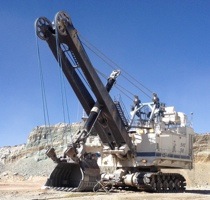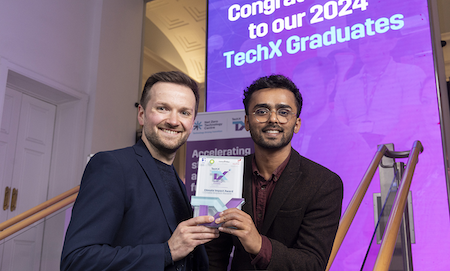Game-changing new technology for mines

MineSense technology is installed in this 65 cubic yard Bucyrus wire rope shovel. — Photo courtesy of Andrew Bamber Vancouver, B.C.-based MineSense
MineSense technology is installed in this 65 cubic yard Bucyrus wire rope shovel. — Photo courtesy of Andrew Bamber
Vancouver, B.C.-based MineSense is heading for commercial production in 2016 of its MineSense suite of sensor-based measurement technology that aims to improve the value of the ore extraction and recovery process.
The company’s platform for evaluating and sorting low-grade ore is based on founder Andrew Bamber’s Ph.D. research into developing a level of sensitivity unprecedented in the mining industry.
The product suite, called the MineSense Solution, runs on a proprietary pre-concentration methodology that decreases the energy, water and chemical requirements of extraction and evaluation processes, improving an operation’s efficiency and profitability.
The technology takes advantage of mining trends indicated by customer-funded studies that the value creation potential of the MineSense product suite is in the billions of dollars.
“Customer-funded activity runs the gamut from sampling and feasibility studies through field pilots and product trials,” said Bamber. “We will continue to expand this activity over the next year to aim for full commercialization of the MineSense Solution at an industrial scale in 2016.”
At any mining operation it is the mill, whether flotation or leaching, that is the biggest consumer of water and energy, said Bamber. Reducing the barren waste going to that process can reduce a mine’s water and energy requirements.
Pre-development tests show that with MineSense a 30 to 60 per cent overall saving is possible, with improvements of 15 to 30 per cent on revenue in addition to 15 per cent savings on the bottom line.
“This is exceeding industry expectations,” said Bamber. “Current customers are asking for five per cent improvement and getting so much more.”
MineSense has two main sensor technology applications. The primary is high-frequency electromagnetic spectroscopy (HFEMS), which is actually an adaptation of a commonly available geophysical tool, EMS.
MineSense has added spectral capacity to the technology, miniaturized it and added digital spectronics to make it accurate and precise in measuring low-grade base metal ores.
“We have complemented the high-frequency EM technology with adaptation of extra fluorescent sensing, which is a surface technology that gives selectivity towards the elements,” said Bamber. “In combination with HFEM, this allows us to sense—in real time and in high speed—a wide range of important commodities including nickel, copper, copper-gold, manganese and other bulk minerals.”
The company is currently developing applications for use in rare earth metals evaluation as well.
The technology’s main application and flagship product is ShovelSense, which applies real time—down to the millisecond—mineral content measurement and reporting in the bucket of the mining shovel.
“ShovelSense brings real-time grade telemetry, derived from measurements taken from the bucket of a shovel, to the mine production control system to make the plan-based decision to apply an ore or waste classification,” said Bamber. “Where this classification is incorrect, ShovelSense can correct it based on the measurement the technology takes.”
The potential of ShovelSense is immense, because it carries the ability to reject material from all feeds and to enhance recovery at the mill while recovering material scheduled for waste.
“It has the potential to really change the game,” said Bamber, “especially since it doesn’t require major changes to the equipment selection or flowsheet of an operation.”
A secondary application of the sensor technology integrates the same sensors, but the adaptation is into an ore-sorting solution called SortOre.
“Our vision is to take the same sensors and integrate them with EM diversion systems and with bulk crushing conveyor systems such as input crushing conveyors,” said Bamber. “The underlying sense is that the ShovelSense and SortOre products satisfy the industry’s need for greater capacity.”
When it comes to sensors and sensor-based sorting, the least satisfied industry needs are sensitivity and capacity, Bamber said.
“Capacity is the big one, where mine operations today are getting pretty big,” he said. “Operations processing 30 million or 100 million tonnes a year are common, and technology for sensing and sorting have to meet those requirements.
“It could be 3,000 or 10,000 tonnes an hour; we meet the requirements of these operations’ technology that integrates with the technology already in place.”
The technology used in the MineSense Solution is the first of its kind and completely unique in the industry, partially because it was created as the result of Bamber's Ph.D. research and partly because it is a hard task to accomplish.
“There is a challenging combination of requirements that make mineral sensing in the shovel in large open pit mines possible,” said Bamber. “It is mineral value telemetry, and the value of that is huge—it doesn’t exist.”
The biggest barrier to market adoption is a combination of misconception and risk adversity among the mining customer base. People complain prices are low and that isn’t true, Bamber said.
“Prices are quite high; they are just not as high as they were in the recent past, and they are not high enough to support the current cost inflation,” he said.
“Cost inflation is derived largely by energy. Mines need more energy, and as they become more energy and capital intensive, the cost goes up. Wishing for high prices doesn’t fix things.”
MineSense has gone through all the stages of a West Coast start-up, from working in labs at the University of British Columbia refining the technology and looking for seed investment to a stage where the team was building in the garage of one of the founders.
The MineSense team went through pre-production with 10 people in a lab sublet and is now a group of 29, potentially growing to 50 next year.
The company recently moved its operations from a 2,000-square-foot head office in North Vancouver to a 20,000-square-foot location that houses the company’s office and manufacturing and laboratory spaces.
Bamber said the company’s time at the smaller location in North Vancouver was an incubation period that was suboptimal for several reasons.
“Moving to Vancouver has given us access to more space with better infrastructure, logistics at lower cost and excellent connections both to downtown and the airport,” he said. “Our ability to attract and retain top-quality people is greatly enhanced at the new location.”
Bamber’s early research was with smaller, high-value nickel and copper, where waste rejection opportunities could be 30 to 50 per cent and results were presenting a 25- to 30-per cent margin enhancement.
When he began to understand the requirements of a large open pit copper mine, it became obvious that improvements of even five per cent moved the dial.
“For mines moving that big an amount, a dollar or two improvement on each tonne can be $200,000 to $400,000 per day in cashflow,” he said.
The technology holds potential in the trend towards deeper, more remote mining operations and the ongoing struggle to find high-grade deposits. Except, said Bamber, it isn’t a trend, because that would indicate the ability to reverse it.
“The reality going forward is that the possibility of new, high-quality discoveries is diminishing,” he said. “The industry needs a new way of operating.”
MineSense is in pre-commercial stages at present and has a number of high-profile customers interested in pilots and trials. The company expects customer acceptance in 2015 and commercial operations by the end of that year.
For more information about MineSense Technologies, visit minesense.com.




